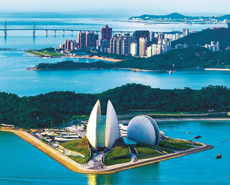
Supply of ferrophosphorus Ti 0.05%max in China tight
----Interview with Wang Haitao
General Manager
Yunnan COSDA Metallurgies Co., Ltd.
General Manager
Yunnan COSDA Metallurgies Co., Ltd.
Yunnan COSDA Metallurgies Co., Ltd. As one of the main processers and traders of ferrophosphorus in China, COSDA Metallurgies has been engaged in ferrophosphorus trading and processing for over 20 years.
Asian Metal: Thank you very much for joining our interview, Mr. Wang, and please introducer COSDA briefly.
Mr. Wang: Yunnan COSDA Metallurgies Co., Ltd established in 1993, and we are mainly doing ferrophosphorus (FeP) processing and trading in Chinese domestic and overseas aboard market. We can supply standard FeP P 24%min, Si 3%max, C 1%max, and FeP Ti 1%max, Ti 0.5%max and Ti0.05%max and other various FeP according to customized specification.


Asian Metal: What's your annual sales volume of ferrophosphorus (FeP)? How does domestic and overseas trading volume account respectively? Please give some quotations.
Mr. Wang: We sell about 20,000 tons a year with domestic trade accounting for about 70 % and export for about 30 %. The common FeP accounts about 60 % and supr-low titanium phosphorous about 40 %. Currently we supply to Baosteel, Shougang, Angang, and Pangang etc. For overseas markets, we offered USD360/t FOB China for common FeP, and USD420/t FOB China for FeP Ti1 %max, and USD430/t FOB China for FeP Ti0.5 %max (if there is no other element requirement) . We are mainly concentrated in the United States, Japan, and European markets.


Asian Metal: How do you evaluate the relationship between supply and demand in China?
Mr. Wang: At present, FeP are wildly used in steel mills and foundry factories, and the annual consumption capacity is about 40,000 tons. Common FeP is mainly for general steel mills, while FeP with low-titanium is for special steel and silicon steel mills. Currently, it's oversupplied in China for common FeP, but due to the updated skills of special steel mills, the demand of super low titanium FeP is obviously increasing.


Asian Metal: The yellow phosphorus plants were exposed about the water-pollution issue, leading to the tight supply of the raw material of yellow phosphorus two months ago. How do you evaluate the current supply of yellow phosphorus? How many of them are producing now?
Mr. Wang: The yellow phosphorus plants were exposed due to the unqualified-water discharge, leading to most yellow phosphorus plants suspended production two months ago.
After equipment rectification for over one month, half of them met the standard and resumed production one after another. There are about 40 yellow phosphorus plants in total in China, and about half of them are currently in production, and most of them who produce common FeP are located in Yunnan, Guizhou, Sichuan, Hunan, Hubei and other regions. At present, the supply of common FeP is sufficient, but the supply of low-titanium FeP (Ti 0.5 % max) is tight. Due to the scarcity of supplies from upstream plants, the low-titanium FeP's price has been rising since the beginning of the year, but it becomes weakened now. As upstream plants gradually resumed production, prices of low titanium FeP would decrease in the future.














